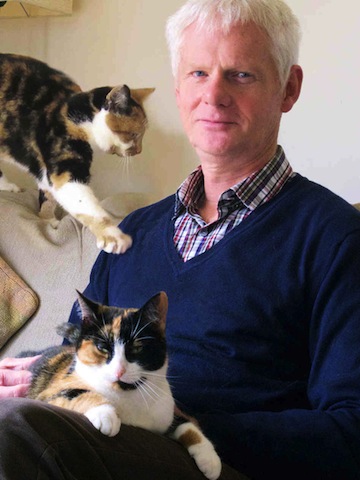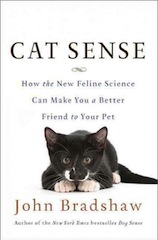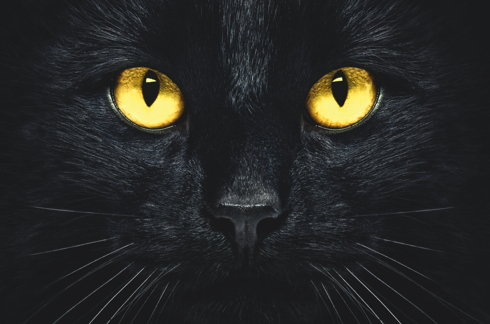Cats. You know ‘em, you love ‘em.
Wait. You might well love cats—well, except of course, for the anti-cat contingent (a significant minority amidst households who live with animals, where cats rule by a 3-to-1 margin.)
But even those of us who are decidedly pro-cat might be hard pressed to state with any conviction that we actually know cats. Sure, cats make lovely companions—they’re low maintenance, they tend to be warm and affectionate, they can be playful and entertaining, and they’re often good company, among many other virtues.
But one rap against our feline friends is that they’re highly independent, often very cool customers, sometimes downright aloof.
To cat lovers, these observations may amount to little more than further character assassination from the anti-cat camp.
Still, all contingents—anti-cat, pro-cat, those who are somehow cat-indifferent—would likely agree on one point: cats can be inscrutable. It’s often difficult to understand them—to really, truly know them…to detect what makes them tick.
John Bradshaw can help.
Bradshaw is an academic, an anthrozoologist—Foundation Director of the Anthrozoology Institute at the University of Bristol—and an author of numerous books, including The New York Times bestseller Dog Sense.
He’s also considered an international cat expert, who’s published a new book, Cat Sense: How The New Feline Science Can Make You A Better Friend To Your Cat.
With Cat Sense, Bradshaw has fashioned a field guide of sorts—historic, scientific, behavioral—that even the most staunch and longstanding cat lover is likely to find fascinating and often-revelatory, at times even controversial.
The book serves as an indispensible boost for anyone seeking help in cracking the feline code, who’d lap up insights about their behavior like a kitten slurping a bowl of cream.
I count myself very much a member of that group–we have four cats at our house—so I invited Bradshaw to join me for a chat Oct. 23 on Talking Animals.
We’d barely said hello, when I was peppering him with questions about purring. If you’ve spent much time with cats, you’ve probably gleaned that it’s a little too simplistic to suggest that a purring cat always means a happy, contented cat.
At the same time, even some longtime cat aficionados might be surprised to learn the sizable array of messages that purring can convey. I was.
“Purring,” Bradshaw explained, “is simply a signal that the cat is giving to you: ‘stay calm, stay close, pay attention to me.’ A lot of the time, it doesn’t mean the cat is [just] contented, but if you do more of the thing the purring is asking you to do, then it will become even more contented.
“But there are some cats that have a kind of different purr, a more urgent purr—it is distinctive. It is the one that they use when they are out of food. Some people consider it an unpleasantly loud purr, which means, ‘give me food.’
http://www.youtube.com/watch?v=2isM0luky9o
‘Why cats get grumpy,’ based on John Bradshaw’s research
“Then there’s another kind, which maybe only veterinarians and veterinarian nurses and people into rescuing cats will have heard, and that is when a cat is in great distress, or even pain, perhaps after being hit by a vehicle.
“And they will purr in those circumstances, when clearly they are not contented. They are asking you to ‘pay attention to me and see what I need.’ That, of course, is very different than the cat curled up on your lap.
Wondering if these very different scenarios might trigger something of a purr patois, I asked Bradshaw how readily a layperson might discern the differences between the sounds of these purrs.
“When the cat making purring noises is in great pain, I think you kind of have other clues as to what’s going on,” he said. “The cat’s body posture would be very tense. You may also be able to see where the cat is hurt. So I don’t think there should be much difficulty recognizing that one.
“The one they do when they want something urgently–usually when they want to be fed–there’s a kind of singing quality to it, and some people have likened that to a baby’s cry. There’s a purr going on, and underneath that there’s a sound a little bit like a crying baby.
“I must say, I‘ve heard it, and I can’t see the analogy to the crying baby. But some people certainly say that is what it reminds them of. And there really is a singing quality to it, as well as a rumbling sound to the purr.”
This notion of cats emitting multi-purpose purrs is far from the only instance in Cat Sense where Bradshaw uses scientific research, behavioral findings—and sometimes-anecdotal evidence–to shake up the status quo. (If you want to instead call that the catus quo, you’re a better wag than I.)

‘…if here in the UK we get to the point where there’s 90 percent neutering in the whole country, then I think there is a question to be asked about whether we’re driving domestication slowly backwards, and should we not actually be putting more thought into targeting neutering, and maybe even developing some new cat breeds, which is one way forward.’
Indeed, in one notable case, Bradshaw moves across the rigorous research continuum away from even anecdotal evidence to something strictly autobiographical, creating a fascinating new wrinkle to the topic of declaw.
Declaw, you may recall from some past Talking Animals columns–is the extremely euphemistically-labeled procedure by which the end of each cat’s toe is amputated.
Cats that undergo this process often experience a host of horrible consequences, including such severe discomfort in their paws that they often can’t endure using the litter box any more (which often leads to an eviction notice from their home) or, unable to defend themselves or otherwise function in their claw-less state, start biting (ditto).
These and other by-products of “declaw” (the word was just named Misnomer of The Month for November, the 11th such honor in 2013) are familiar to those knowledgeable about the practice. Especially those hoping to outlaw it in more parts of the U.S., akin to the way it’s banned in Bradshaw’s native UK, and a slew of countries.
However, what’s not familiar about declaw, at least to me, is a possibility that Bradshaw posits in the book: that cats in their post-declaw lives might be haunted by phantom pain. In our radio chat, Bradshaw elaborated.
“There’s a lot of nerve endings in the cat’s paws, and in removing the claw, and the last toe bone—those have to all be severed. So it occurred to me, from my personal experience that the cat has to deal with this, for many months–or years—afterward that phantom pain may well be part of it.
“I guess we’re all familiar with a veteran coming out of the army with an amputated leg then they get phantom pain, which can be very distressing. It can keep the guy up at night, and all sorts of things.
“But at least as humans we have the ability to look at it and say ‘Actually, I know my leg isn’t there anymore and the pain—however real it feels—is not real. I don’t have to attend to my leg; I have to deal with the pain. But I know my leg doesn’t have a problem, because it’s not there anymore.’
The Cat Connection: from the BBC’s Natural World, a study of the human-cat connection from antiquity to the present.
“I had an accident many, many years ago, when I was in my 20s,” Bradshaw continued, “where I lost the tip of my ring finger on my left hand. It was replaced, but only kind of cosmetically. The nerve endings had all gone. The bone on the end was shattered. And for many years afterward, I used to get phantom pains in that finger.
“They weren’t particularly bad. I’m not saying I was in the same position as a veteran who lost a leg, or anything like that. But it just made me think; if that’s happened eight times to a cat—and that’s what it would be to a cat: eight toes will have had the ends removed, if it’s just the front claws. And of course, it’s 16 if it’s the back one done too, which not many people do.
“There’s every possibility—phantom pain is not something that comes with consciousness. It presumably comes with every animal. It’s just a property of a mammalian nervous system. So cats should get phantom pains, just the ways that humans do. They just don’t have the language to tell you about them.
“So I suspect this may be a problem. And they do tend to have very tender feet for a while after the operation, and this may be part of it… I don’t have any direct evidence for it. It’s just something I’m raising as a possibility. If we humans can get it, why not cats?”
It’s a fair question, certainly.
Bradshaw poses a number of intriguing queries as Cat Sense traverses a great deal of territory, including in the literal sense, tracing the historical path of cats to companions (“The first clear indication that cats had transformed themselves into pets come from Egypt, just over 4000 years ago”), as well as floating intriguing concepts to ponder, like the phantom pain possibility, and engaging in some myth busting here and there.
For instance, it’s commonplace for cat owners, new and old, to deal with their exasperation over the family feline depositing a newly-caught carcass somewhere in the house by explaining it away as a love offering, a gift. Perfectly reasonable explanation. But, from Bradshaw’s standpoint, it’s a thick slice of baloney—the party line notwithstanding, he does not buy at all that this gesture is remotely as magnanimous.
“No, I think that’s something that a lot of people believe. And of course, the cat does behave as if it is, if he drops a little dead mouse in front of you. If a person did that—well, hopefully, it wouldn’t be a dead mouse,” he said, laughing. “But you’d kind of get the idea that it was a gift.
“But I can’t see how that would have evolved, that the cats would have that in mind. I think what they’re really doing is simply bringing the prey home to somewhere where they think they may begin to eat it. In a safe place, where they couldn’t be ambushed by another cat, or whatever.
“They remember that mice, or whatever the [prey] happens to be, aren’t all that great to eat. That is known. Virtually all the better quality commercial cat food available today is far tastier than anything they’re likely to catch for themselves.”
I have to confess this information arrived as a depressing slap in the flap, not quite on the order of learning last year there was no Santa Claus, but jarring nonetheless.
I’ve lived with a few cats over the years who’ve left birds, rodents and other prey for me as a love token—or so I thought. And I know plenty of other cat lovers who’ve had similar experiences, and assigned similarly benevolent meaning to the carcasses that turned up. Oh, well….
But absorbing this reality revision felt like child’s play alongside a trenchant observation Bradshaw makes in Cat Sense about spay-neuter. Spay-neuter, of course, represents the methods of sterilizing cats (and dogs) by removing their reproductive ability—a female is “spayed,” a male is “neutered.”
While there are other benefits, the chief virtue of spay-neuter is the way the procedure helps erode the massive pet overpopulation. That staggering overpopulation carries countless dark repercussions, not least that cats (and dogs) in shelters and other facilities are routinely euthanized—ok, killed—because there simply aren’t enough folks adopting them, there aren’t enough homes for these animals.
In animal welfare circles, and beyond, spay-neuter is widely viewed as a profoundly important panacea for all sorts of scenarios, large and small, including controlling the feral cat community.
So it made for a disorienting curveball, if not downright heresy, when Bradshaw declared what he sees as the potential long-term downside of spay-neuter. What? I mean, that’s like someone attacking The Affordable Care Act. Okay, maybe not the best example at the moment, but you know what I mean. I asked Bradshaw to explain the thinking behind this assertion.
“Spay-neuter is a fantastic thing,” he acknowledged, “for the welfare not only of pet cats but also feral cats, which we can allow to live in areas—not always where people want them to be, but at least without reproducing lots of kittens, that get sick and die and create all sorts of problems for the people around them, too.
“In principle, it sounds like a fantastic idea, it sounds like a win-win. The cats get to live, and their welfare is improved at the same time. What I’m kind of pointing out in the book is that, in the future, if we carry on doing that, and we carry on taking kittens from re-homing, from feral cats and so on, which is a great thing to do in principle, of course. But if we repeat it over and over again, we’re actually driving domestication backward.
“Because we’re neutering all the animals that are actually getting on best with us and we’re taking kittens and young cats from cats that are basically living independently. We’re not there yet, except in a few places. In the UK here, there are some areas where neutering rates are well above 90 percent and there are not enough kittens being born to satisfy local demand, so they’re being brought in from other areas.
“So there are still plenty of kittens to go around. But if here in the UK we get to the point where there’s 90 percent neutering in the whole country, then I think there is a question to be asked about whether we’re driving domestication slowly backwards, and should we not actually be putting more thought into targeting neutering, and maybe even developing some new cat breeds, which is one way forward.
“That are not developed to look pretty, not to develop for the show ring—they can come in any color you want. But are developed for having the very best temperament. The easiest cats to socialize. The ones that get on with other cats. The ones that don’t hunt. And the ones that are easy to get along with their owners, and their children. That sort of thing.”
Even though his view is clearly framed as the longest of long-term thinking, Bradshaw’s time-delayed criticism of spay-neuter, and attendant recommendation for a form of social engineering, will surely kick up tremendous controversy, if it hasn’t already.
As with other truly effective sages in any other realm, Bradshaw may help us understand how cats think, behave and evolve in a manner that yields significant enlightenment, yet in doing so, may himself sometimes seem as enigmatic and challenging as the critters whose conduct he so deftly decodes.
Still, I have it on good authority that when a cat who writes a monthly column about animal issues recently profiled the British anthrozoologist, the first words he tapped out—claws intact, by the way—were:
John Bradshaw. You know him, you love him….
Click here to listen to the Oct. 23 Talking Animals, featuring the interview with John Bradshaw.





